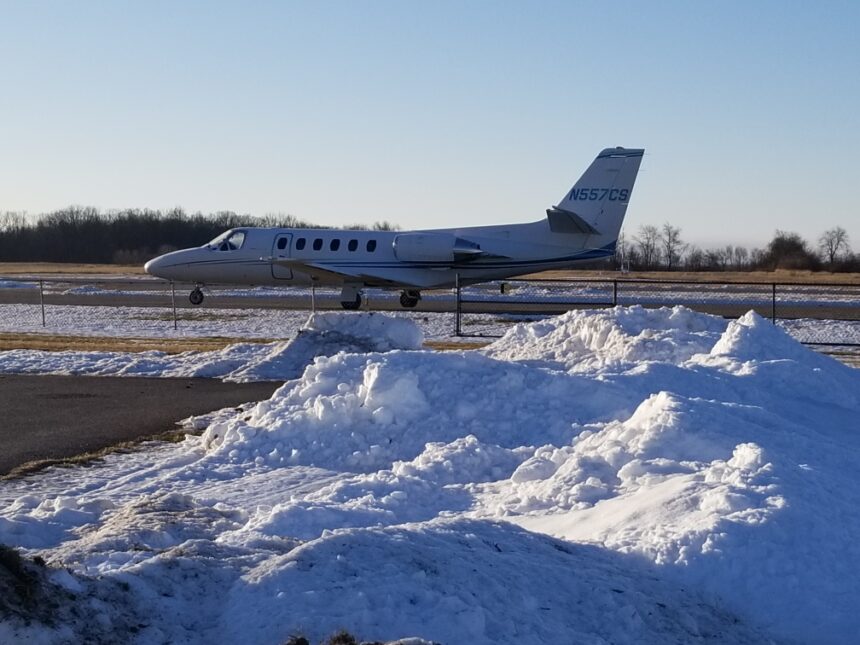Airport staff keep runways clear of ice and snow during the winter. Olivia Hajicek | Collegian
“Hey, how’s your runway look?” a jet radioed to the Hillsdale Municipal Airport on Friday.
“Looks great,” Airport Administrator Ginger Moore said.
“Okay, we’ll be landing around 3 o’clock.”
Pilots often call the Hillsdale Municipal Airport during winter to make sure the 5,000-foot runway is safe for landing. The airport keeps everything clear for winter flights, making sure that pilots and flight students can safely land their planes.
Moore said it is up to pilots to determine whether conditions are safe for landing their planes, as the airport is an uncontrolled field.
“Usually we just have a radio in the plow truck so we can listen to see if anyone’s coming in, and then the pilots can decide. We can tell them what the runway conditions are, and it’s up to them to decide if they want to try coming in or not.”
She said they very rarely close the runway altogether.
“The only time we would close the runway so they couldn’t come in is if we had a really heavy snow event and we couldn’t get the snow off the runway,” Moore said. “But no one would really be flying during that anyway, so it’s never been really a big issue.”
Moore said the airport has not seen much snow yet this winter.
“The first time we used our plow truck was actually this last snow that we just got,” she said, referring to the Jan. 25 snowfall. “When it snows and we get an inch or two, we get the plow truck out and start plowing — the active runway first, then the taxiways, and then the parking lot and driveway.”
Line Manager Steve Boyd said they have a plow truck like the ones on the county roads, but cannot use salt as it would cause metal on the planes to rust.
“When it snows we take that out and we just start plowing from the center of the runway to the outside of the runway to keep it clear,” Boyd said. “You can’t use salt or anything on the runways or tarmacs or anything like that.”
Staff rely on snow blowing and plowing, with a little help from the sun, to keep the runway as dry and clear as possible. Boyd said they have to be careful where they scrape the snow.
“If we can get it scraped down to the asphalt as quick as possible with the sun coming out, it will dry it out,” Boyd said. “You want to keep the piles of snow at a low height because of the wings of the plane.”
He said they also need to keep the runway as smooth as possible and free from ice chunks.
“It’s a major no-no for a plane,” Boyd said, “because airplanes can’t dodge.”
According to Boyd, planes can have equipment like de-icer, rubber boots, and heated propellers to help them navigate icy conditions, though planes mostly kept in warm climates don’t usually have these features. While large planes are built to burn off ice, Jack Cooperwasser, a certified flight instructor at Skywalker Flying in Adrian, said it can be a much worse problem for small planes.
“We gain more weight, we gain more drag, and we lose lift, so all bad things,” Cooperwasser said. “Even frost, if there’s an eighth inch of frost, we can lose lift by as much as 40% and increase drag by as much as 30%.”
Boyd said students at flight schools in Jackson and Adrian sometimes fly into the airport for practice. Cooperwasser said he has flown into the Hillsdale airport 10 or 15 times, usually in training flights.
“Funny enough,” he said, “I had a friend who went to Hillsdale, and so I picked her and her boyfriend up a few times at Hillsdale and brought them back to Ann Arbor where her parents are.”
Cooperwasser said flying in the winter is actually easier in many ways.
“You have better performance. You have more lift. The engine performs better,” he said. “The airplane overall just performs better both aerodynamically and with engine power.”
Cooperwasser said dealing with clouds is an exception. He said he teaches new pilots to avoid them.
“Sometimes it can be a bit of a pain because clouds are usually a little lower in the winter,” he said. “In our trainer aircraft we don’t have any way to get rid of ice if we collect ice on our airplane, so we have to stay out of clouds because that’s where icing can happen in the winter. Anytime there’s visible moisture, for example clouds, it is possible to get icing.”
Cooperwasser said a plane cannot take off again until the ice has melted. He said extreme cold can cause problems too. “If it gets too cold, like if it goes below zero degrees Fahrenheit, we might come across some other issues. The engine might start coughing, wanting to quit on you. If you shock-cool it, if we jam in the throttle too fast, that’s too much cold air into the engine at once and it might choke the engine and stall.”
He said this usually happens when they make a quick landing and then take off again, what pilots call a “touch and go.”
![]()

